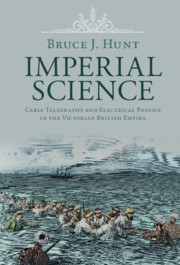Book contents
- Imperial Science
- Science in History
- Imperial Science
- Copyright page
- Contents
- Figures
- Acknowledgments
- Abbreviations
- Prologue: “An Imperial Science”
- 1 “An Ill-Understood Effect of Induction”
- 2 Wildman Whitehouse, William Thomson, and the First Atlantic Cable
- 3 Redeeming Failure
- 4 Units and Standards
- 5 The Ohm, the Speed of Light, and Maxwell’s Theory of the Electromagnetic Field
- 6 To Rule the Waves
- Epilogue Full Circle
- Bibliography
- Index
5 - The Ohm, the Speed of Light, and Maxwell’s Theory of the Electromagnetic Field
Published online by Cambridge University Press: 11 December 2020
- Imperial Science
- Science in History
- Imperial Science
- Copyright page
- Contents
- Figures
- Acknowledgments
- Abbreviations
- Prologue: “An Imperial Science”
- 1 “An Ill-Understood Effect of Induction”
- 2 Wildman Whitehouse, William Thomson, and the First Atlantic Cable
- 3 Redeeming Failure
- 4 Units and Standards
- 5 The Ohm, the Speed of Light, and Maxwell’s Theory of the Electromagnetic Field
- 6 To Rule the Waves
- Epilogue Full Circle
- Bibliography
- Index
Summary
James Clerk Maxwell’s field theory of electromagnetism had important and previously unrecognized roots in the cable industry of the mid-nineteenth century. When he took up electrical physics in 1854, the subject was permeated by a concern with cable problems. Guided by William Thomson, Maxwell soon adopted Faraday’s field approach, which in 1861 he sought to embody in a mechanical model of the electromagnetic ether. Seeking evidence to bolster the electromagnetic theory of light to which this model had led him, Maxwell joined the British Association Committee on Electrical Standards, which had been formed in 1861 largely to meet the needs of the submarine telegraph industry. Maxwell’s work on the committee between 1862 and 1864 brought home to him the value of framing his theory in terms of quantities he could measure in the laboratory—particularly the “ratio of units”—rather than relying on a hypothetical mechanism. Maxwell’s shift from his mechanical ether model of 1861 to his seemingly abstract “Dynamical Theory of the Electromagnetic Field” of 1864 thus reflected the often overlooked role concerns rooted in cable telegraphy played in the evolution of his thinking.
Keywords
Information
- Type
- Chapter
- Information
- Imperial ScienceCable Telegraphy and Electrical Physics in the Victorian British Empire, pp. 181 - 215Publisher: Cambridge University PressPrint publication year: 2021
